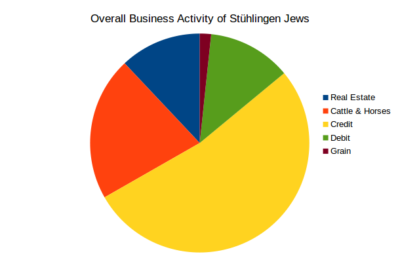⇑ 64 65 66 67 68 69 Page 70 71 72 73 74 75 76 77 78 79 ⇓
8-6
¶ 1 Leave a comment on paragraph 1 0 But rather than focusing on individual transactions or merchants, let us examine the overall commercial pattern of the Stühlingen Jews, based on the abstracted records (fig. 7). These records mainly mention just the fact and character of a transaction without providing its numeric value.
¶ 2
Leave a comment on paragraph 2 0
 Figure 7. Overall pattern of Stühlingen Jews’ business activity.
Figure 7. Overall pattern of Stühlingen Jews’ business activity.
¶ 3 Leave a comment on paragraph 3 0 Among the 4826 collected records, we identified 2630 commercial transactions involving 131 Jewish merchants. Because of the nature of the records, we simply counted the transactions according to type, independent of their value. We found 1387 credit records, 324 debit records,32 559 cattle and horse deals, 316 real estate deals, and 44 grain transactions. The relatively small part the grain trade played in the business spectrum of the Jews may appear surprising at first glance. But the requirement for a hefty infrastructure for transportation and storage, largely barred to them, may offer a plausible explanation. We have to accept that the initial recording of transactions was probably incomplete, that documents may have been lost over the intervening three hundred years, and that the data capture from the archives was incomplete. The data set available for analysis thus constitutes only a sample from the universe of business deals transacted by the Jewish merchants of Stühlingen between 1604 and 1743. We have no reason to suspect deliberate bias. But we do not know the threshold value above which transactions had to be recorded. We may have slightly oversampled cattle and horse deals because they seemed to have given rise to legal repercussions more frequently than other types of transactions; the reason for this will be discussed later.
32Both from the perspective of Jewish merchants.

Comments
0 Comments on the whole Page
Login to leave a comment on the whole Page
0 Comments on paragraph 1
Login to leave a comment on paragraph 1
0 Comments on paragraph 2
Login to leave a comment on paragraph 2
0 Comments on paragraph 3
Login to leave a comment on paragraph 3
0 Comments on paragraph 4
Login to leave a comment on paragraph 4